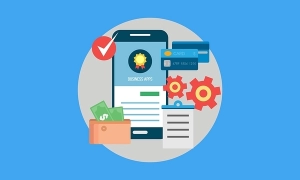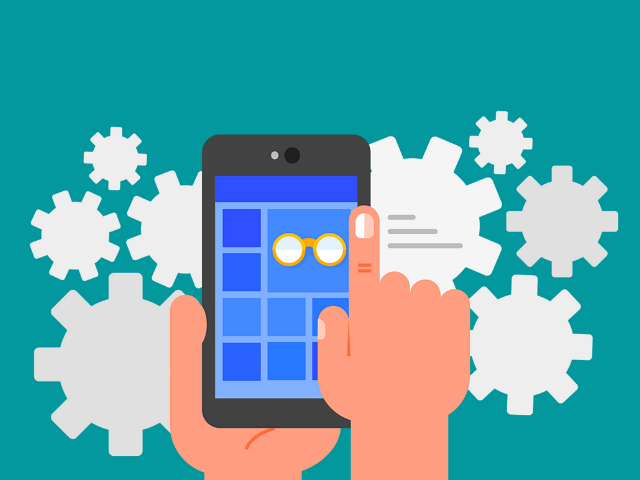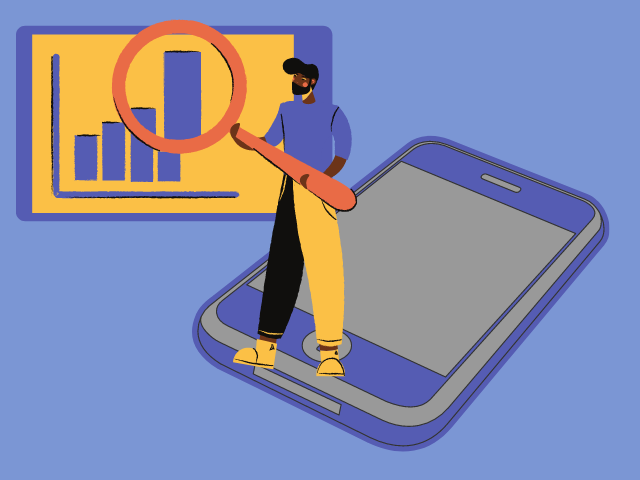
Mobile solutions are available not only to large corporations, as they used to be, but also to small businesses. To gain a competitive advantage and improve service are the main reasons why brands turn to developers for help. Such products become the main marketing tool and assist business owners and their teams in solving daily tasks. Therefore, having mobile software is an integral part of the life of businesses, which can streamline processes in the company.
It will not be enough just to make a business app. The solution has to stand out from your competitors, be tailored to your objectives, help build connections with customers, and finally generate revenue. The procedure for making a business plan, researching the market, competitors, and target audience is quite complicated. After and before the release of the app, you need to think about promotion. In addition to all the challenges, the owner is also required to invest a lot of money.
In this article, we'll look at how to make an app for your business step by step and assess all the risks, as well as the prospects. Moreover, you will find out how not only to benefit but also to avoid any mistakes resulting in financial losses.
Basic Notions and Perspectives of How to Create a Mobile App for my Business
A mobile application (or an MA) is software designed for specific functionality. There are two types: native and cross-platform (hybrid). The first ones are optimized solutions to work on one platform, and the second apps can be used on several platforms. People download them from such marketplaces as AppStore or Google Play. To understand what kind of business app you need, let's analyze their pros and cons:
- Native. The advantages include speed and performance; a high level of security; the ability to work offline. As for the disadvantages: high cost; only one platform is involved; long-term development process;
- Hybrid. Strengths: speed of development; cross-platform; availability of offline update option. Weaknesses: poor performance without the Internet; average speed; minimalism in design.
If you're still thinking about "How to create a mobile app for my business?" and haven't come to the final decision yet, you should be aware of the following things:
- Forecast for the end of 2022: People will download over 200 billion apps, and the average usage time will be 4 hours a day;
- With the help of apps, businesses will automate their day-to-day operations. For instance, clients will be able to book their tickets themselves, and employees will process orders/calls more quickly;
- Apps generate over 45% of revenue. In comparison with websites, mobile software has a 3-4% higher conversion rate.
How to Build a Business App to Maximize Benefits
To fully realize the benefits of an MA for your enterprise, you need to understand how it works. There are two big parts of the application system: front-end and back-end.
The front-end is a visible part of your MA, and the user interacts with it, and the back-end refers to the hidden part, with which the developer works through the server software. By forming a split system, we get a program that works on the user and developer sides.
Back-end allows brands to analyze data about their target audience, set up loyalty policies, and increase sales.
If you build a business app according to all the development rules and principles, you will get a number of benefits:
- More sales. If mobile traffic used to be considered an additional channel for attracting potential customers, today, everything has changed fundamentally. Every year, the sales market is moving to the mobile environment, so brands have only one thing to do — create apps for their businesses and develop mobile channels;
- Loyalty. Customers don't want to search for websites, where they will make purchases. An MA simplifies this process with a few clicks, which has a favorable effect on profits;
- Metrics monitoring. With MAs, organizations can track and collect important information about users and adjust performance metrics;
- Support. If the application acts as a user support center, it will build effective communications with clients;
- Cost-cutting. Adding push notifications to your system is a way to reduce your marketing costs. An MA also helps lower staffing costs.
I Have a Website, Why Should I Create a Business App?
If you have your own website, great! In the future, it can become a center for the promotion of your mobile software. But the question is: why should you spend money when there is a solution that works and brings good results?

The answer can be found by looking at current trends and statistics. What do people use more often, mobile devices or computers? The answer is obvious — people want to be mobile so they watch movies, make decisions, and shop on the go. Thus, you should at least think about how to create a mobile app for your business.
What if you convert the site, and the user can interact with it from any device? Of course, you can redesign this resource or create a copy of the main desktop website and customize it to the resolution you need. However, you should bear in mind the traffic and sales. With an MA, these indicators will be much higher. It can be explained by the fact that the adaptive website has a low level of interaction with users. Hence, the upgraded site is inferior in lead generation.
Besides, when you make a business app, you will have a complete package of features and functions that work only on your phone or tablet. For example, reminding customers about an incomplete purchase, some features can work offline, storing personal data, etc.
Types of Mobile Applications for Organizations
Companies and startups use mobile apps to plan, communicate with clients and colleagues, give tasks to employees, and monitor progress. Each MA differs in design, complexity, and functionality. Based on these features, let's define what kind of applications there are:
- Scheduling apps. These are services that help you set tasks for your team and control the implementation of projects;
- Remote access applications. Create your business app to ensure a connection between a particular PC and a user located far away from it;
- Communication apps. Programs for online business meetings, audio or video calls, and file-sharing;
- Sales apps. This MA is for customers, where they can easily select and purchase products.
Android vs iOS
Applications are also differentiated by the operating system. There are dozens of various operating systems on the market, but we will discuss those that occupy 80% of the market: Android and iOS. The main difference between them lies in the fact that an MA with the iOS operating system is installed only on Apple devices. What does this mean? A business owner should understand that if they create an iPhone app for their business, they will reach a smaller part of the TA since there are more devices with the Android OS.
The advantages of iOS are the convenience, the interface style, and the lack of compatibility problems. Despite all the pros, one of the drawbacks in the development process is careful moderation when uploading an application to the store. Furthermore, this OS has a closed file system, which does not allow you to explore its interior.
Now, let’s find out how to make a business Android app and evaluate the chosen OS.
Android has more strengths than the first option: any computer is suitable for work, publishing MAs to marketplaces is fast, programs can run on smartphones, smartwatches, Smart TV, as well as solutions can be adapted to any specialized task.
Android also has plenty of cons. For example, the fragmentation of platforms — the variety of devices makes it difficult to test and debug applications. Because of the large variety of pages, developers have to create copies for each version.
Fortunately, you don't have to select one particular OS for your business since there are solutions like hybrid MAs.
How to Create a Business App: On Your Own or Using a Third-Party Provider
Who will handle the development? Brands have two ways, which we have mentioned above. Choosing the right one depends on a number of factors. For example, for large companies that have all the necessary resources, it is more effective to start development on their own.
Writing programs with the support of third-party contractors fits smaller ventures. In this case, the business needs to think through a strategy and discuss it with specialists. This way, the owner generates the idea, and the developer writes the code.
Creating a Business App: Step-by-Step Guide
Consistency is what comes first. When brands set a goal, they define a direction and draw a road map. Otherwise, you can only succeed if you're very lucky. About the same thing happens when you create a unique app for your business.
Here are some other rules to follow:
- Design. The visual part is not only about the aesthetic aspect but also about usability;
- Process. Planning and calculation are the basis of any project;
- Testing. Checking hypotheses and programs to make sure they are running properly is what will save both time and money;
- Strategy. It is necessary in any project, and in this case, both for development and promotion;
- Team. The outcome depends on it. Thus, you have to find specialists who are experienced and have a similar vision for different things.
Business Plan
This document helps structure a course of action, think through development strategies, and provide for market risks and prospects. Each section of the business plan is devoted to different issues, which will allow the owner to analyze the time and financial costs, and how the idea will be implemented.
The key aspects for the MA planning documentation are choosing the type of service and its concept, determining the platform, drawing up the terms of reference, calculating the budget and timeframes, as well as the promotion strategy. Meanwhile, IT agencies can assist in compiling it.
Create an App for Business: Stages
Let's take a look at the steps that each successful application takes so that you realize which phases to follow. Conventionally, this process can be divided into a preparatory period, a development stage, and a post-release phase.
The first stage is considered to be the longest one because this is where specialists gather all the necessary information, test hypotheses, and build a plan of how to create a business app for phones.
Initial Phase
- Concept. At this point, it's important to determine whether or not you have a working idea that solves a particular problem. Don't be intimidated by the fact that your application will have similar features to other services. The main thing is to stand out from the competitors;
- Goals. Clearly formulated objectives identify further progress. Use the SMART system for that. This will help facilitate the most productive time management and use of resources. Measuring success is done through key performance indicators;
- Research. Building a business app without market research is not a good idea. It helps gather information about the target audience and competitors. Next, the data is processed to determine the purpose of the product, who the potential customer is, the feature set, the design of the MA, and other details;
- Functionality. Add only those features that can solve the user and business problems. If you include additional unnecessary things, it will distract from the main goal. Besides, any add-on means one more element of your expenses;
- Framework. The main purpose is to illustrate functions and schemes. It is developed without taking into account the graphic design, so the layout is usually shown in a schematic version in a digital tool.
Development
- Terms of Reference. To make a business app, there is a document containing the client's requirements for the product. It covers the features that should be in the application, describes the owner's design preferences, and contains other basic information. Additionally, the paper outlines the budget, team structure, activities, deadlines, and more;
- MVP. It is a minimal viable product that helps you determine how the final solution will look and run. Moreover, it's the kind of tool that will definitely save you money and time. The ready-made MVP is offered to the TA so they can test it, and then, the business can get feedback. After 2-3 weeks, the IT agency receives reviews, assesses the product's performance, and fixes it;
- Development and testing. When all the steps are taken and a business app has been designed, the next stage is testing. A QA specialist should check your MA several times. And the best solution for you is to perform usability testing with real people;
- Launch and support. After startup, you can continue to work with the agencies so that they provide instant support in case of any failures or scaling.
Post-release
When you have already created a business app with a great design, after researching the market, the TA, and the competitors, think about how to make it visible. We are talking about promotion, which involves developing a marketing strategy. The main goal is to increase the percentage of downloads and sales within the application. Huge potential for growth comes with paid promotion. Therefore, along with the question of "How to create an app for my business", you need to figure out how to make it marketable.
Fundamentals of promotion:
- Draw up marketing strategies;
- Use analytics to know which channels are potentially more attractive for advertising;
- Establish a budget;
- If you have an Android app, use Universal App Campaign, and for iOS — Apple Search Ads;
- Promote the app on social media and take advantage of opinion leaders;
- Drive visitors through the website by using SEO.
Keeping track of key performance indicators — KPIs — will help assess the success of the strategies. Make sure you have a system that lets you know:
- Percentage of downloads;
- The app uninstall rate;
- Time-of-use data.
To build a business app and not to analyze the statistics means to operate according to the method of guesswork. Hence, you need to have specific figures.
To determine how successful your product is, feedback from real customers will also help. Their reviews will prioritize it. You should also remember about improving your MA, like releasing new updates, adding new options, and so on. Keep in mind, regression testing after the modifications provides the best user experience.
What Is the Price to Create an App for Your Business?

The cost depends on several aspects. These are design, functionality, platform, development of the server part, and testing. Let's consider each point separately and then give some recommendations that will allow you to save money without sacrificing quality.
- Design. The more elements you have in your MA (sections, pages), the higher is the price;
- Features. Each option increases the cost. Thus, it is better not to overload the program;
- Platform. If you want to know how to create a business app with a smaller budget, you should choose one platform, Android or iOS. A hybrid option, respectively, will be more expensive;
- Servers. For example, plugging in a ready-to-use application system will be cheaper than if you develop server mechanisms;
- Testing. The costs associated with evaluating software performance depend on the number of pages and functions.
The average cost of development from scratch will usually start at $10,000 for a business and may reach $200,000 or even more.
4 Best Ways to Save Money
The tips that will help reduce the overall cost without sacrificing quality are as follows:
- Unnecessary features. At the very beginning, create a list of the most essential options and do not add those that do not meet the needs of your potential users;
- Don't reinvent the wheel and use ready-made solutions;
- The team. You can hire an agency to help you figure out how to create a business app. It can be a firm based in Silicon Valley or you may choose from another region where the prices are lower;
- Gather materials for the designer. If your organization has its logo, brand books, and other graphic elements, provide them to your designer. Many of these things can be useful for development.
What is not worth saving money on? It is the basic functions, a pre-study of the market and the needs of the TA, design, and testing.
How Long Does It Take to Build a Business Mobile App?
The development time, as well as the cost, varies depending on many factors. The engineering part of the process takes approximately 3-4 months (without the preparatory stage, development, and post-release). During this time, the business will only get the MVP.
Keep in mind also that to make a business app, you need time for preparation (research, writing terms of reference, etc.). This can take up to 3-4 weeks.
How quickly you can get your MA also depends on your team, development methods, and more. To affect the speed of this process, you need to hire the right team, stay consistent, and always test hypotheses.
Final Thoughts
After answering your question about how to create your own business app, we can summarize this article with a few conclusions. It's not an easy task to build a business app, but having an MA will give the business and its customers more benefits and reasons to interact. As a result, it will lead to increased sales, employee productivity, and improved quality of service.
This article is a handbook for those brands who want a top-notch solution that satisfies the needs of their audience. We hope that you have got valuable information, and the marketplaces will see your product soon.
FAQ
What should I know before starting to build an app for my business?
Application development is divided into 3 phases: preparation, development, and post-release. Each stage has its own purposes and cannot be excluded from the process. Thus, before you start developing, you need to study the market and your target audience, create an application framework, and draw up the terms of reference for the team.
How much does it cost to create a business app?
It is impossible to answer this question with a specific figure. On average, brands invest from $10,000 per project. The final price depends on the complexity of the product.
What is the average time to create an app for business?
It takes about 6-12 months to develop a complex application and up to 6 months for a relatively simple solution.
Why do you need to build a business application development team?
The number of specialists in the team depends on the scale of the project. The main group of specialists includes a manager, a designer, and developers.


